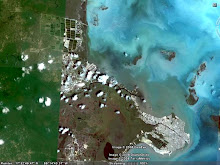 The excavator has been hard at work at Aqua Mar shrimp farm removing old sediment from the sedimentation pond.
The excavator has been hard at work at Aqua Mar shrimp farm removing old sediment from the sedimentation pond.At Royal Maya shrimp farm, we have been regularly cleaning and recalibrating the In Situ probe and collecting the data for further analysis.
We've had a few bumps and we're a bit behind schedule, but we're getting good baseline data and things are moving ahead.
As the Uni High summer vacation moves ahead, keep thinking creatively about the project and checking back on the blog. If you find something interesting, go ahead and post it. We'll be ready to dive back in when school starts in fall.




The probe looks great. I actually had a question about all of the sedimentation. Just a thought, since I'm not sure whether there is any agriculture or farming in the area, but assuming that the sedimentation is rich in nutrients, would it be viable to use it as some sort of fertilizer? I remember you mentioning that after each cycle, the bottoms of the ponds have to be cleared of all the leftover biomass. I noticed in the pictures that there is some sort of vegetation growth around the ponds. Instead of piling it up, could we use it somewhere else?
ReplyDeleteHi Amy! Sorry I missed this. Things have been on hold for a bit.
ReplyDeleteYou are correct that shrimp pond sediments can be used as fertilizer. In a shrimp production pond most of those sediments are actually shrimp feces or the remains of shrimp feces. Some of the farms here have done exactly what you suggest. The sediments are scraped up and left on the banks of the ponds. Once the rain washes the salt out of the sediments, plants are able to take root and protect the banks from erosion. In this particular sedimentation pond there is more inorganic matter like clay in the sediment and it's
less useful for fertilizer.